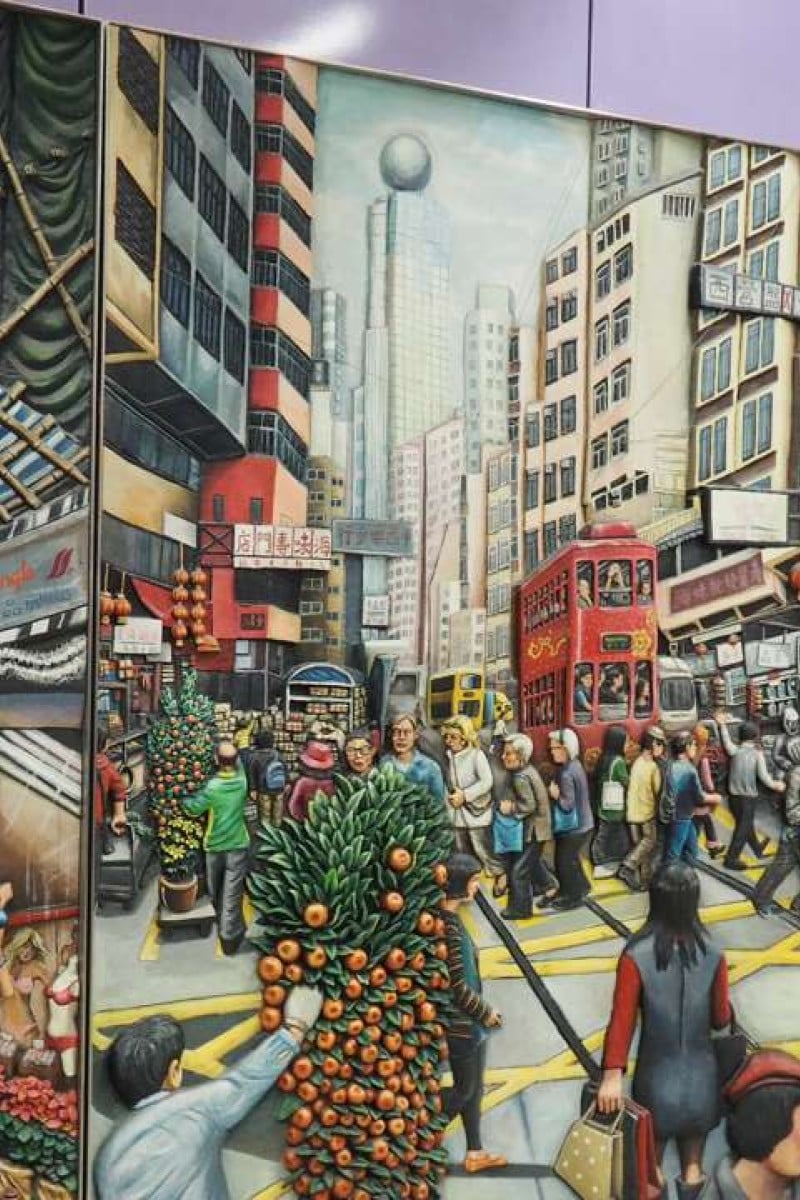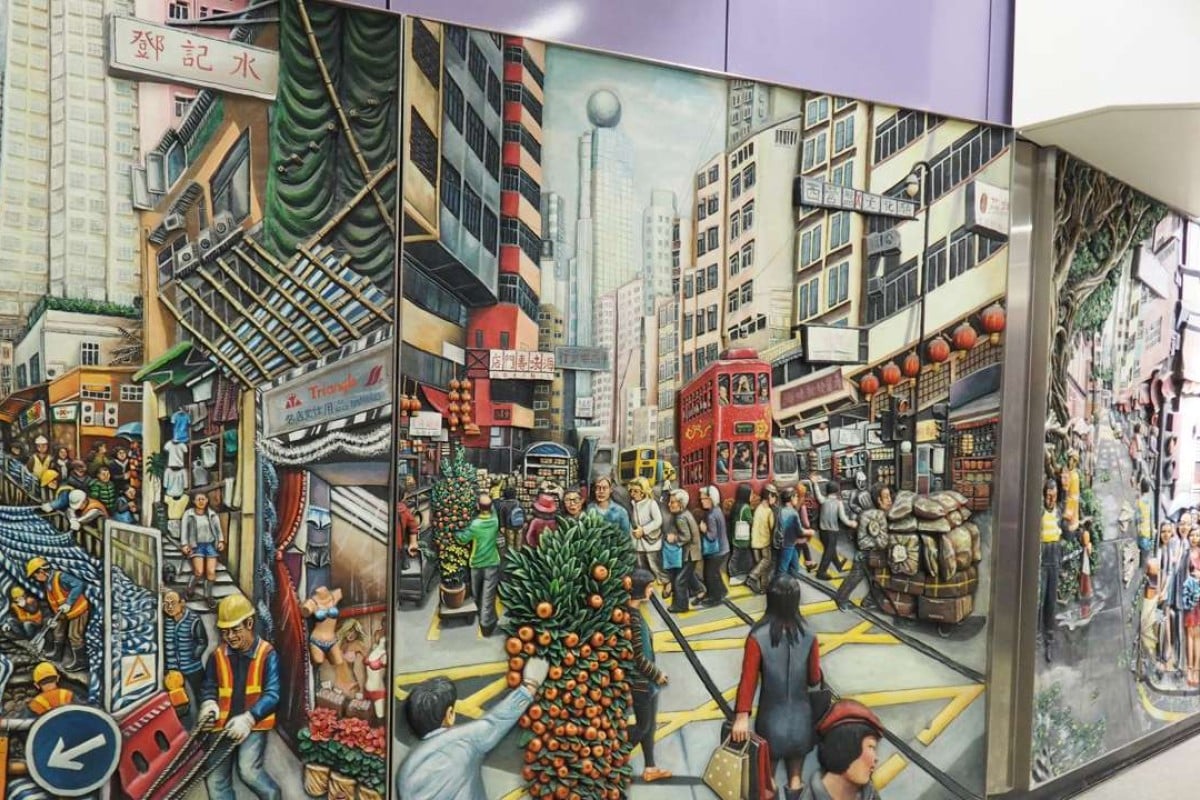
Sai Ying Pun’s stand-out art: who created the 3D artwork on the walls of the MTR station?
If you’ve been through the MTR station at Sai Ying Pun lately, you’ll probably have seen the 3D artwork on the walls as you pass through. Louise Soloway Chan, the artist, explains why she chose the images and visuals that she did
 Chan’s artwork comes from the many photos that she has taken in the area.
Chan’s artwork comes from the many photos that she has taken in the area. Louise Soloway Chan stood in Sai Ying Pun MTR station in the early hours of the morning and witnessed the crowning moment of six years of hard work. The local artist created all the 3D artwork – or “bas-relief panels” – on display throughout the station. Instead of celebrating with an opening ceremony in January, the MTR corporation simply opened its doors, leaving passengers on the 6.03am train to discover the new art for themselves, while Chan breathed a sigh of relief.
Chan, who was originally from Britain, but has lived in Hong Kong since 1994, told Young Post that her favourite thing in the world is people-watching, which is why she came to create the vivid daytime scenes that adorn the 12 panels. She had created similar snapshot pieces for the airport and private customers, and decided to pitch her work to the MTR after seeing commissioned art at Central and Lok Ma Chau stations.
“A friend suggested I should do something before Sai Ying Pun opened, as they knew the whole area was going to change,” she says.
The project was literally up her street – she lived in the area and had a catalogue of drawings and hundreds of photos documenting street scenes and small businesses, like hairdressers and fruit stalls. She received a call back straight away, telling her the MTR was interested in her work. In Chan’s words, it was a case of the right email sent at the right time.
“Then they told me the amount of space I needed to fill, and I thought ‘I can’t do that!’ It was way bigger than my studio. And my husband said, ‘You’ve got to do it. I’ll help you, we’ll work it out’,” she remembers. So she set about deciding which scenes should feature on her panels. “I walked methodically around the area up and down and took loads of pictures. I wanted to make the panels seasonal, and it was Lunar New Year at the time. I was wondering what details I could include when I saw a guy wheeling by with an orange tree. The scenes just happen, they unravel.”
She took the same approach for panels themed with summer and typhoons, keeping one eye always open for interesting or quintessentially Sai Ying Pun scenes. However, she also drew inspiration from Ap Lei Chau, where her studio is based.
“You wouldn’t know it, but a few of the images are taken from Ap Lei Chau. I often walk around the wet market there and just study the characters,” she reveals. “I’ve left all the Ap Lei Chau people as they are, and I’m waiting for the day that these people realise. I see them around a lot, and wonder if I should tell them they’re on the panel.”
Not everyone welcomed the artist’s lens though: she recalls one pet owner getting cross when she took a picture of their cat, and traditional medicine vendors getting upset when she went to take a snap of some shark fins. But, slowly and painstakingly, she blended different aspects from all her photos and drawings into the designs for the panels.
As an artist who specialises in snapshot scenes, Chan thinks a lot about how quickly time flies. Her lantern shop panel (in which, if you look closely, you can spot a cameo by the artist) is filled with Angry Birds lanterns, which were popular when she was working on that piece.
“Now you go round the lantern shops and you wouldn’t see Angry Birds – it’d be whatever the latest cartoon trend is,” she says, adding, “Perhaps the passing of time is what subconsciously motivates me – capturing places as they are.”
Her observations take on a bittersweet note when subjects or businesses depicted in the panels have disappeared from the area. “There are a lot of things that have gone. It’ll be interesting to see how quickly my work looks historical,” she says. “There was a little old-fashioned barbershop which has gone now, so I’m pleased that made it onto the wall.”
Chan enjoys visiting the MTR station to anonymously watch how people react to her work: from couples posing, to police officers closely studying the uniforms on the reliefs, to large groups of old ladies pointing at the minibuses zipping down Chan’s colourful streets. Weighing 280kg each and coated in thick varnish, the reliefs are very hard-wearing, but a little damage is inevitable for public artwork. During construction, one of the characters’ arms got chipped. “Someone from MTR stuck a plaster over it and it looked quite perfect. I did go back and fix it, though.”
She adds, “Sometimes people with strollers or bags bash into them, so they get a bit battered. Children are always poking them! But I’m happy it’s there for everyone.”
